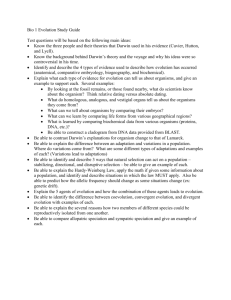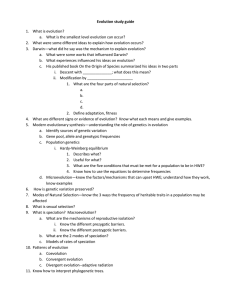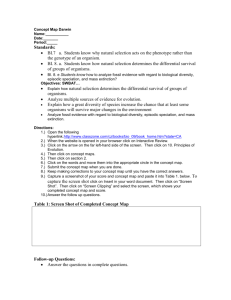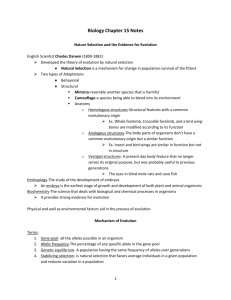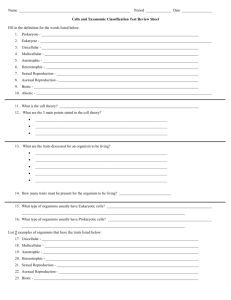Evolution and Classification
advertisement
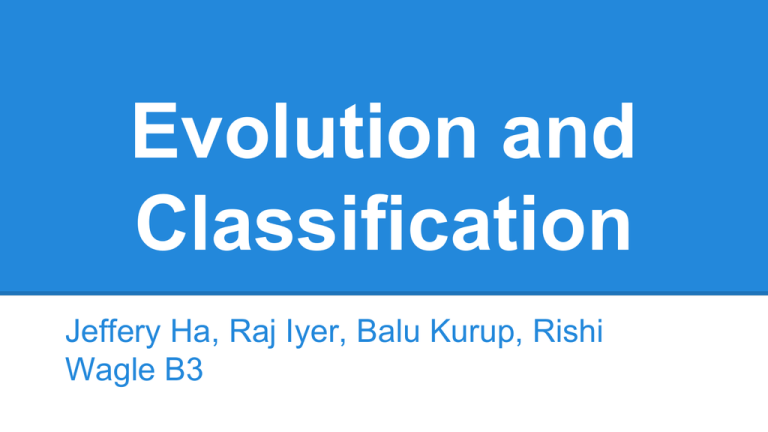
Evolution and Classification Jeffery Ha, Raj Iyer, Balu Kurup, Rishi Wagle B3 Evolution ★ Darwin’s principle of Natural Selection a. Variation - individuals within a population possess heritable variation within traits Sexual recombination and Mutations. b. Overproduction- organisms produce more organisms than can survive. c. Competition- those with suitable adaptations will outcompete others. d. Differential Survival- Those with suitable characteristics tend to survive more. e. Differential Reproduction- those with favorable traits will survive and pass on the traits to their offspring Individuals do not evolve, but populations do!! Selection Mechanisms a. Directional- those at one end of the spectrum is favored so the graph shifts Disruptive- those at each ends are selected, the median is not favored. Stabilizing- those in the median area is favored. a. Sexual selection- preference of certain characteristic in the opposite sex. c. Genetic drift- successful organisms may leave genes behind Bottleneck Effect- an event that reduces population to small numbers and variation in species. Founder Effect- loss of genetic material upon introduction of a new species. d. Gene Flow - transfer of genes from one population to another, creates genetic variation. Lines of Evidence for Evolution 1. Fossil Record- buried fossils of organisms and ancestors 2. Biogeography- how the species were distributed across the world 3. Convergent evolution- not closely related organisms develop similar traits due to their environments and adaptations. 4. Comparative anatomy- study of body structures of different species. 5. Homologous structures- similar body structures in different species due to a common ancestor. 6. Comparative embryology- similarities and differences among embryos of different organisms. 7. Artificial selection- breeders selectively breed based on certain desired traits (dog breeding, crops, babies) Hardy-Weinberg Equilibrium ● Equations o o p+q=1 p2 + 2pq + q2 = 1 ● Conditions o o o o o Infinitely large population Random mating No mutations No gene flow (migration) No selection Speciation ● Ernst Mayr developed biological species concept (BSC)-a species is a population that can interbreed and produce viable, fertile offspring ● Types of speciation: o Allopatric-geographically isolated populations o Sympatric-populations in the same environment adapt to different niches; incl. adaptive radiation (organisms diversify into many new forms) Speciation (cont.) ● Mechanisms for speciation: o Pre-zygotic: habitat factors, temporal factors, behavioral factors, mechanical factors, gamete factors o Post-zygotic: reduced hybrid variability, reduced hybrid fertility ● Rate of speciation: o Gradualism-change is the product of slow but continuous processes o Punctuated equilibrium-species stay the same for a long time, followed by periodic outbursts of change Origin of Life ● Earth is 4.5 billion years old ● Abiotic origins of Earth o o o Atmosphere contained CO2, CH3, and NH3 which was energized by lightning and UV rays and resulted in formation of organic compounds Same idea was shown in the Miller experiment This led to the formation of protobionts and later bacteria around 3.5 billion years ago Miller Experiment Domains ● Cladograms, or phylogeny trees, illustrate the relationship between the 3 domains ● The 3 domains are eubacteria, archaebacteria, and eukarya Characteristics and Examples of Each Domain ● Bacteria (eubacteria) : unicellular prokaryotes, no membrane bound organelles, single circular chromosome, peptidoglycan cell wall, asexual reproduction; Ex: Bacillus, Streptococcus ● Archaebacteria : unicellular prokaryotes, cell wall, cell membrane, ribosomes, no membrane bound organelles, DNA + histone proteins, single circular chromosome, asexual reproduction; Ex: Methanococcus, Halobacterium ● Eukarya : unicellular & multicellular eukaryotes, membrane bound organelles, nucleus, mitochondria, chloroplasts, Golgi apparatus, ER, lysosomes; Ex: animals, plants, fungi Eukaryotic Kingdoms ● Protista are either autotrophs or heterotrophs, and only some have cell walls and cell membranes. They reproduce mainly through asexual methods such as binary fission and budding. They are mostly unicellular, and move via flagella and cilia ● Fungi are heterotrophs which use absorption with cell walls composed of chitin. They reproduce through mostly sexual methods, except for unicellular yeast. Examples include yeast and mushrooms ● Plantae are autotrophs which utilize photosynthesis with cell walls composed of cellulose. They reproduce through sexual and asexual methods, and include mosses, ferns, gymnosperms, and angiosperms ● Animalia are heterotrophs without cell walls, and they reproduce sexually. They include all multicellular organisms, invertebrates, and vertebrates. Eukaryotes: Plants Eukaryotes- Animals Animals- Mammal Subgroups ● Monotremes- egg-laying mammals with no mammary glands, e.g. duck-billed platypus, echidna ● Marsupials- pouched mammals, e.g. kangaroo, koala ● Placentals- fully developed placenta, e.g. rodents, primates, canines, felines FRQ: 2001 AP Biology Exam, Question 2 Intro: Charles Darwin proposed that evolution by natural selection was the basis for the differences that he saw in similar organisms as he traveled and collected specimens in South America and on the Galapagos Islands. FRQ: Part A A. Explain the theory of evolution by natural selection as presented by Darwin. FRQ: Part B B. Each of the following relates to an aspect of evolution by natural selection. Explain 3 of the following. i. Convergent evolution and the similarities among species in a particular biome ii. Natural selection and formation of insecticide-resistant insects or antibiotic-resistant bacteria iii. Speciation and isolation iv. Natural selection and behavior incl. kinesis, fixed-action-pattern, dominance hierarchy, etc. v. Natural selection and heterozygote advantage Answer to Part A A. Explain the theory of evolution by natural selection as presented by Darwin. (worth 6 pts; each concept below worth 1 pt) Reproductive potential: the ability to over produce Variability: inheritable changes or mutations linked to variability Limited resources: biotic or abiotic Competition: intraspecific struggle for existence Differential Reproduction: reproductive success of variants Generations: time needed for evolution to occur Elaboration: expansion of Darwin’s ideas such as the effects of environmental change or artificial selection or good, linked example Answers to Part B B. Explain three of the following. (2 pts, per section of B) i. Convergent evolution and similarities among species in a particular biome - Different species exhibit adaptations as a result of the same environment - Correct descriptive example linked to biome and survival value or linked to natural selection ii. Natural selection and the formation of insecticide-resistant insects or antibiotic-resistant bacteria - An inherited characteristic enables the organism to resist the effect of the toxin - Specific example, mechanisms of resistance, or extensive elaboration or link to natural selection Answers to Part B (cont.) B. Explain three of the following. (2 pts, per section of B) iii. Speciation and isolation - A single population divides into two reproductively isolated populations or equivalent (use of gene pools) - Role of barriers in speciation or discuss gene pool separation or link to natural selection iv. Natural selection and behavior - Define or describe the behavior - Give a clear example of how this behavior enhances survival or link to natural selection v. Natural selection and heterozygote advantage - Survival value of heterozygote over both homozygotes - An example of how the heterozygous enhances the survival of the organism or link to natural selection

